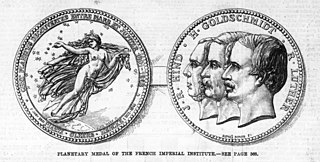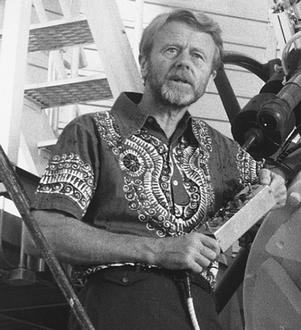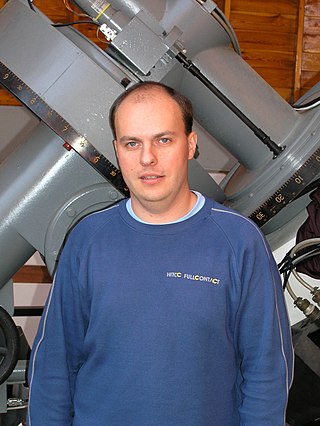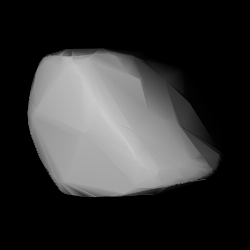Related Research Articles

Ejnar Hertzsprung was a Danish chemist and astronomer.

Hermann Mayer Salomon Goldschmidt was a German-French astronomer and painter who spent much of his life in France. He started out as a painter, but after attending a lecture by the famous French astronomer Urbain Le Verrier turned to astronomy. His discovery of the asteroid Lutetia in 1852 was followed by further findings and by 1861 Goldschmidt had discovered 14 asteroids. He received the Gold Medal of the Royal Astronomical Society in 1861 for having discovered more asteroids than any other person up to that time. He died from complications of diabetes.

Johann Palisa was an Austrian astronomer, born in Troppau, Austrian Silesia, now Czech Republic. He was a prolific discoverer of asteroids, discovering 122 in all, from 136 Austria in 1874 to 1073 Gellivara in 1923. Some of his notable discoveries include 153 Hilda, 216 Kleopatra, 243 Ida, 253 Mathilde, 324 Bamberga, and the near-Earth asteroid 719 Albert. Palisa made his discoveries without the aid of photography, and he remains the most successful visual (non-photographic) asteroid discoverer of all time. He was awarded the Valz Prize from the French Academy of Sciences in 1906. The asteroid 914 Palisana, discovered by Max Wolf in 1919, and the lunar crater Palisa were named in his honour.

Maximilian Franz Joseph Cornelius Wolf was a German astronomer and a pioneer in the field of astrophotography. He was the chairman of astronomy at the University of Heidelberg and director of the Heidelberg-Königstuhl State Observatory from 1902 until his death in 1932.
Schelte John "Bobby" Bus is an American astronomer and discoverer of minor planets at the Institute for Astronomy of the University of Hawaii and deputy director of NASA's Infrared Telescope Facility (IRTF) at the Mauna Kea Observatory in Hawaii, United States.
Zhang Yuzhe, also known as Yu-Che Chang, was a Chinese astronomer and director of the Purple Mountain Observatory who is widely regarded as the father of modern Chinese astronomy. He studied the light curves of asteroids, and thus their rotation periods. He also researched the variable star CZ Cassiopeiae and the evolution of the orbit of Comet Halley. Zhang discovered 3 comets and is credited under the name Y. C. Chang by the Minor Planet Center for the discovery of one minor planet, the outer main-belt asteroid 3789 Zhongguo.

George A. Van Biesbroeck was a Belgian–American astronomer. He worked at observatories in Belgium, Germany and the United States. He specialized in the observation of double stars, asteroids and comets. He is notable for his long career as an observational astronomer.

Alexandre Schaumasse (1882–1958) was a French astronomer and discoverer of comets and minor planets.

Anton M.J. "Tom" Gehrels was a Dutch–American astronomer, Professor of Planetary Sciences, and Astronomer at the University of Arizona, Tucson.
Maura Tombelli is an Italian amateur astronomer who began her training in astronomy as an observer of variable stars. She is a prolific discoverer of almost 200 minor planets, including the main-belt asteroid 7794 Sanvito, and a member of the American Association of Variable Star Observers.
Farpoint Observatory is an astronomical observatory owned and operated by the Northeast Kansas Amateur Astronomers' League, or NEKAAL. It is located on the grounds of Mission Valley High School at Eskridge, near Auburn, Kansas, approximately 30 miles (48 km) southwest of Topeka, Kansas, United States.

The Haute-Provence Observatory is an astronomical observatory in the southeast of France, about 90 km east of Avignon and 100 km north of Marseille. It was established in 1937 as a national facility for French astronomers. Astronomical observations began in 1943 using the 1.20 m telescope, and the first research papers based on observations made at the observatory were published in 1944. Foreign observers first used the observatory in 1949, when Geoffrey and Margaret Burbidge visited.

The Ondřejov Observatory is the principal observatory of the Astronomical Institute of the Academy of Sciences of the Czech Republic. It is located near the village of Ondřejov, 35 kilometres southeast of Prague, Czech Republic. It has a 2-metre wide telescope, which is the largest in the Czech Republic.

Ian P. Griffin is a New Zealand astronomer, discoverer of minor planets and a public spokesman upon scientific matters. He is currently the Director of Otago Museum, Dunedin, New Zealand. Griffin was the CEO of Science Oxford, in Oxford, United Kingdom, and the former head of public outreach at NASA's Space Telescope Science Institute.
The Junk Bond Observatory is located in the Sonoran Desert at Sierra Vista, Arizona, United States.

Kamil Hornoch is a Czech astronomer who discovered dozens of novae in nearby galaxies. The main belt asteroid 14124 Kamil is named in his honour.
21795 Masi, provisional designation 1999 SN9, is a Nysian asteroid from the inner regions of the asteroid belt, approximately 3 kilometers (2 miles) in diameter. It was discovered on 29 September 1999, by Italian amateur astronomer Franco Mallia at the Campo Catino Astronomical Observatory in Lazio, Italy. The likely S-type asteroid has a rotation period of 13.86 hours. It was named for Italian astronomer Gianluca Masi.

1781 Van Biesbroeck is a Vesta asteroid from the inner regions of the asteroid belt, approximately 8.5 kilometers in diameter. It was discovered on 17 October 1906, by German astronomer August Kopff at Heidelberg Observatory in southern Germany. It was named after astronomer George Van Biesbroeck.
Brian Dale Warner is an American amateur astronomer and computer programmer. In 2006 he was awarded the inaugural Chambliss Amateur Achievement Award by the American Astronomical Society.
Tenagra Observatory and Tenagra Observatory II are astronomical observatories in Cottage Grove, Oregon and Arizona. The observatories house heavily automated robotic telescopes.
References
- ↑ "Minor Planet Discoverers (by number)". Minor Planet Center . 4 May 2018. Retrieved 29 May 2018.
- 1 2 3 Schmadel, Lutz D. (2007). "(21795) Masi". Dictionary of Minor Planet Names – (21795) Masi. Springer Berlin Heidelberg. p. 867. doi:10.1007/978-3-540-29925-7_9687. ISBN 978-3-540-00238-3.
- 1 2 3 4 5 "Gianluca Masi's Bio". www.virtualtelescope.eu. 28 September 2007. Retrieved 29 May 2018.
- ↑ "Scientist uses stars to date Van Gogh art". UPI. 28 September 2007. Retrieved 29 May 2018.